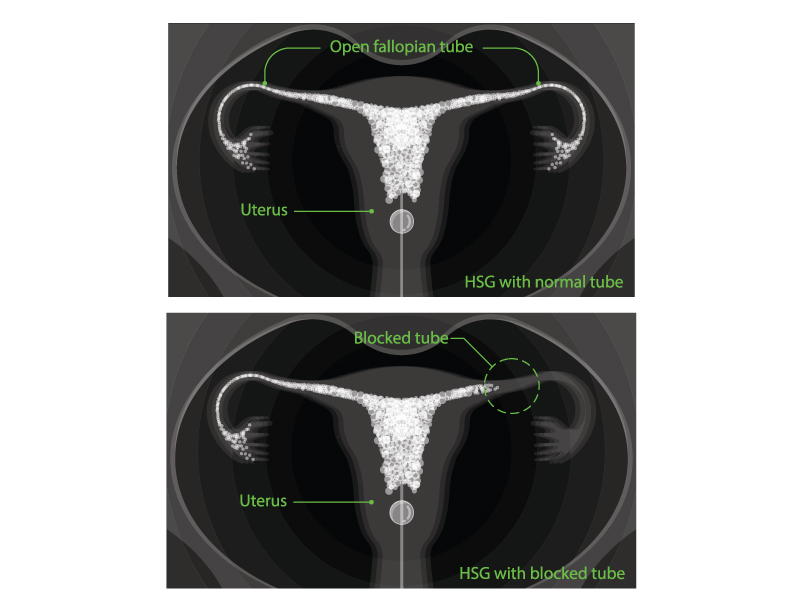
Hysterosalpingogram (HSG) Test for Blocked Fallopian Tubes
Introduction
Why HSG?
What To Expect Before?
What To Expect During?
Side-Effects
Next Steps
Cost
Conclusion
Introduction
What is Hysterosalpingogram (HSG)?
A Hysterosalpingogram (HSG) or an HSG Test is a procedure involving a series of X-rays to see if the fallopian tubes are open and the insides of the uterus are normal. This is an important procedure to determine female infertility.
Why HSG?
For a pregnancy to take place, ovulation needs to take place every month, the uterus needs to be in good shape and your fallopian tubes need to be open. If the fallopian tubes are blocked, then the sperm won’t be able to reach the egg and the fertilised egg cannot reach the uterus.
There are many reasons for blockage of the fallopian tube and the doctor will diagnose it with the help of an HSG Test. The scan also shows irregularities in the uterus such as fibroids or abnormal shape that can help the doctor determine further scans and tests or specific treatments.
What To Expect Before?
What To Expect Before HSG Test?
Here are a few things your doctor will guide you about before an HSG Test:
- The procedure will likely be performed between day five today ten of your menstrual cycle. This would be right before you ovulate and a time when you’re less likely to get pregnant.
- A painkiller injection will be administered an hour before the HSG, or the doctor will prescribe an over-the-counter painkiller medication
- You might also be asked to take an antibiotic based on your medical history
- While you may be alright after the procedure, it is better to bring along a relative or a family member or a friend with you in case you don’t feel well later
What To Expect During?
What To Expect During HSG Test?
- You will be asked to lie down on an examination table under an X-ray imager called a fluoroscope
- A speculum will be inserted in the vagina to widen it and access the cervix. The cervix will then be cleaned, and a small catheter will be inserted into the cervical canal and in the uterus
- The speculum will then be removed, and you will be asked to keep your legs straight
- A dye solution will then be pumped into the uterus while the fluoroscopy machine will examine your pelvic area. You may feel some cramping when this happens
- If your fallopian tubes are blocked, they may stretch from the pressure
- If your fallopian tubes are open, the dye will be seen spilling and spreading to your bowels
- The doctor may ask you to move in different positions to see how the dye moves through the fallopian tubes
- Once enough imaging is done, the doctor will remove the cannula from your body
Side-Effects
Side-Effects of Hysterosalpingogram (HSG) Test
Some women may experience one or more of the following side effects after a Hysterosalpingogram (HSG):
- Mild discomfort or pain
- Cramping
- Dizziness
- Upset stomach
- Nausea
- Small amount of vaginal bleeding for a day or two
If you experience any of the following, you must call your doctor as it may indicate an infection:
- Vaginal discharge
- Fever
- Chills
- Fainting
- Vomiting
- Heavy vaginal bleeding
Next Steps
Next Steps After HSG Test
After an HSG Test your doctor will inform you of the results. In case of blocked fallopian tubes, the doctor may advise such as a laparoscopy for further diagnosis. The doctor may also recommend In-Vitro Fertilisation (IVF) or a surgical procedure. These are complex decisions that must be discussed with the doctor. Your doctor will advise you about the best possible options.Cost
Cost of HSG Test
The price of an HSG Test is Rs 9010/-
Conclusion
A Hysterosalpingogram (HSG Test) helps determine female infertility by examining the fallopian tubes. Your fertility doctor will recommend whether you need this test and based on the results of the test, you will also be told what the next steps would be. While this test has some side-effects, they go away on the same day and one can resume their daily activities soon.
To know more about HSG test cost and other fertility-related treatments call us at 080-67238900 or click here to book your appointment with our top fertility specialists at Motherhood Fertility & IVF Centers.
Relevant Videos
Related Services
First step towards infertility is correct diagnosis and NOT treatment.
FAQs
A Hysterosalpingogram is a series of X-rays taken to examine blockages in the fallopian tubes and determine the shape and normalcy of the uterus. It is a procedure to determine female infertility.
Women may experience minor side-effects after the procedure such as cramping, nausea, dizziness, upset stomach, and mild discomfort or pain. It is advisable to bring along a family member or friend during this procedure.
In very rare conditions, radiation or the dye might pose some risks. It is hence very important to discuss your medical history with the doctor before the procedure.
